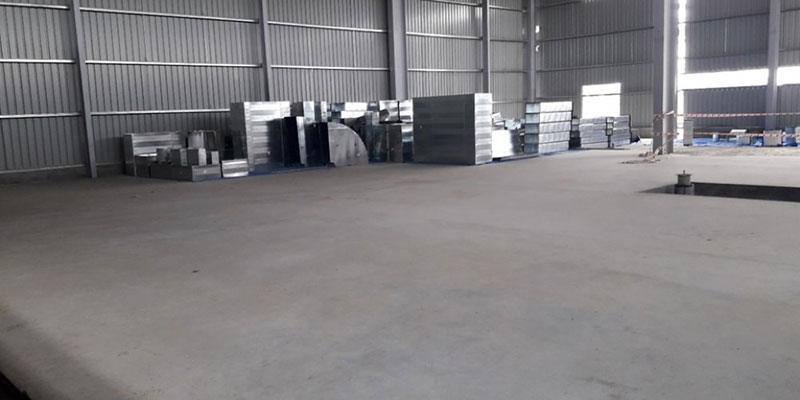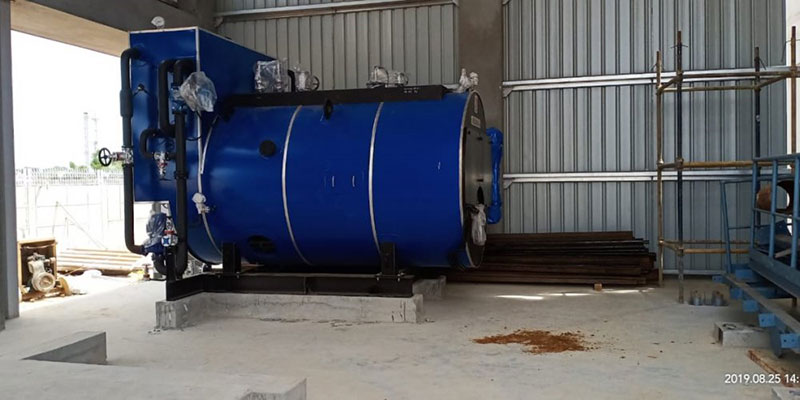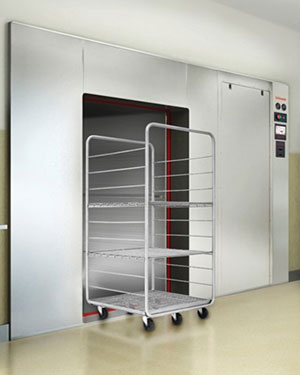It is important to the build project, to the construction workers, and to Micronclean India employees, that we follow traditional rituals performed when building a factory in India.
A "pooja" is an act of worship. This groundbreaking pooja was conducted prior to digging the foundations. It is recommended in the traditional Indian system of architecture – the Vastu Shastra, which gives guidance on how to integrate architecture with nature.
The ceremony is designed to bless the land and to give the people running the project the confidence that they will succeed. The same guidance is used when building homes, temples and even entire cities.
Progress and timeline
As you can see from the latest site photos, the factory build process is well underway. The laundry building has been constructed. The cladding is now almost complete, the mezzanine floor has been constructed, and internal works are underway (e.g. laying drains, installing sprinkler system).

The secondary buildings have also been constructed. Of these, the most important is the large utilities building. This will house key equipment and machinery including the electrical transformers, boilers (note the large chimney) and the water recycling system.
During the final week of August, the first items of equipment were delivered to site. The boiler arrived, and the cleanroom air ducting was delivered. Equipment will arrive thick and fast over the coming months. One of the key challenges on site will then be the coordination of the various contractors to ensure that installation is achieved accurately and efficiently.

The build process has proceeded broadly according to plan. As things stand, Micronclean expect to have the factory handed over for commissioning and validation in January 2020, and hope to be operational by April 2020.
Cellular plant design
The company will be implementing a new plant layout in the Micronclean India facility. The plant is designed in a cellular layout. One production cell will handle a given set of batches, and individual batches will not be mixed within the cell. A batch will be made up at goods in.
There will be no storage of work in progress at any point midway through the process. A line clearance is completed at each step to ensure the garments in the batch remain together, and the next batch can only be handled at that step once the line clearance for the previous batch has been completed. This is an example of a 'pull' process.
Micronclean hope this will make for a more organised, more efficient production environment.

Pass-through autoclaves
Sterilisation autoclaves
In the UK, Micronclean uses gamma irradiation to sterilise garments. In India we will use a different sterilisation technology – steam sterilisation using autoclaves.
The autoclaves will be 'pass through' type, built into the wall of the cleanroom between the main cleanroom and the packing area.
Once garments are folded and packaged, they will be loaded into a trolley (as pictured). The trolley is wheeled into the autoclave, the door closes, and the sterilisation process will take place. Once complete, the door on the packing room side will open, the trolley wheeled out, and the garments will be unloaded for secondary packaging, labelling and sorting.
This technology will allow us to take responsibility for garment sterilisation and will reduce overall turnaround time for sterile garments. We also expect that steam sterilisation will be less damaging to garments when compared with irradiation, so garment life might increase.
Semi-automatic sorting
One of the challenges the company will face in operating a factory in India is the variety of languages that might be spoken by people in the plant. To overcome this, it decided to plan to work instructions and Protrack software as visual as possible, minimising the use of text.
One area in which this will be apparent in the laundry is the garment sorting process. Much like in the Skegness cleanroom laundry, there will be a packing cleanroom in which garments will be sorted and loaded into hampers ready for dispatch.
To increase the efficiency and accuracy of this process without using language, there will be a semi-automatic sorting process implemented. This will consist of a number of ‘bins’ that garments will be sorted into according to customer requirement prior to bagging up.
Protrack has been adapted so that, when a garment is scanned at the sorting station, it illuminates a light above the correct sorting bin. We hope that this system will be easy to train operators to use and should allow them to perform the sorting task quickly and accurately without the need to read text instructions.
Water recycling
Availability of sufficient, clean water is a severe environmental issue in India. As people from the countryside move to the cities, demand for water in cities is growing very rapidly. In some parts of the country, there is not enough safe water, therefore the government is having to implement emergency plans to assure future water supply.
One key government initiative is to encourage new build factories to implement water sustainability measures. This has led us to investigate the opportunity to recycle the water we use.
Laundry is a naturally water-intensive industry, and therefore it is important we take the issue seriously and find out how we can be more sustainable. We have worked with water system suppliers to develop a water recycling system that will allow us to reuse more than 90% of the effluent that would normally go down the drain.
The system will take the effluent from the drain channel, will pass this through a heat exchanger (to recover as much of the energy as possible – also great for sustainability!), and then it will be passed through several stages of treatment – chemical, biological, filtration, and then several stages of reverse osmosis. This will allow us to recover the majority of the water we use back to a suitable quality to use in our process.
It will be challenging to optimise this water system when the plant becomes operational. However, we are very excited about this development. If it works, then there might be an opportunity to bring similar ideas to our UK facilities.

